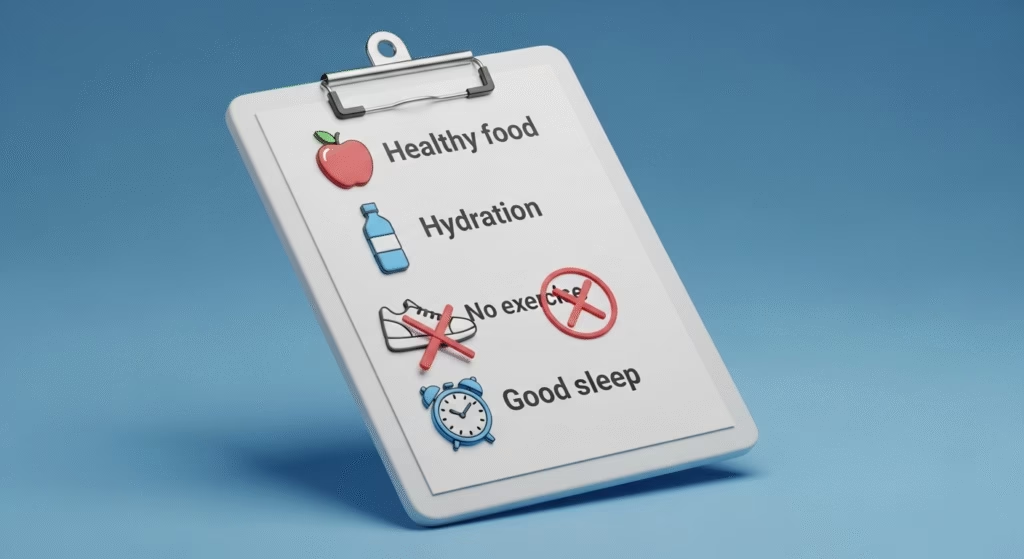Mike Miller, a 40-year-old software engineer, felt a surge of confidence. He and his wife, Sarah, had chosen the right type of policy and calculated their exact coverage need. They were in the home stretch of securing their family’s future! Then, an email landed in his inbox with the subject line: “Scheduling Your Paramedical Exam.”
Suddenly, a new wave of anxiety hit him.
Your Guides for Today: The Miller Family
To make things simple, we’re using a fictional family to explore this topic.
- John & Mary (60s): The retired grandparents, focused on preserving their wealth and legacy.
- Mike & Sarah (40s): The parents, navigating their peak earning years, a mortgage, and saving for the future.
- Leo & Emily (Teens/Kids): The next generation, learning the basics of money.
This box is skippable for regulars but invaluable for newcomers.
“An exam? Like, with needles?” he asked Sarah later that evening, his voice betraying a hint of nervousness. “What if my cholesterol is a little high from the holidays? Will that mess everything up?”
It’s one of the biggest hurdles in the insurance buying process. For many applicants, the life insurance medical exam can feel like a high-stakes test you can’t study for. The fear of the unknown—what do they test, what are they looking for, how do I prepare?—can cause major stress and even stop people from getting the coverage they need.
But it doesn’t have to be this way. The exam is actually a simple, convenient, and surprisingly quick process. To prove it, we’re going to walk you through Mike’s entire experience, step-by-step, to demystify what to expect and show you there’s truly nothing to fear.
What is a Paramedical Exam and Why Do I Need One?
Before we follow Mike on exam day, let’s clarify the “why.” A life insurance policy is a risk calculation for the insurer. To give you the best possible rate on your policy, they need an accurate, up-to-date snapshot of your health. A life insurance medical exam provides exactly that.
Think of it this way: you are rewarded with a lower premium for providing this health data. An applicant who completes a medical exam will almost always get a significantly cheaper rate than someone who opts for a no medical exam life insurance policy. Ultimately, the 30 minutes you spend on the exam can save you thousands of dollars over the life of your policy.
It’s important to know this isn’t a full physical with your doctor. It’s a quick visit from a licensed medical professional (a paramedic) at a time and place of your choosing.
How to Prepare for Your Life Insurance Medical Exam
A week after the email, a friendly scheduler called Mike to set up his appointment. He chose 8:00 AM the following Tuesday, right in his own home before work. To ensure the most accurate results, the scheduler gave him a few simple preparation tips.
Here is a simple checklist for the 12 hours before your exam:

- Avoid Strenuous Exercise: A heavy workout can temporarily affect kidney and liver function readings. A gentle walk is fine.
- Skip Alcohol and Caffeine: Both can temporarily elevate your blood pressure. Mike regretfully skipped his morning coffee on exam day.
- Limit Salty and High-Cholesterol Foods: To get the best reading on your lipid panel, avoid a big, greasy meal the night before.
- Drink Plenty of Water: Good hydration makes for an easier blood draw.
- Fast for 8-12 Hours: This is essential for accurate blood sugar and cholesterol results. For his 8 AM appointment, Mike simply stopped eating after 8 PM the night before.
- Have Your ID and Medications List Ready: Have your driver’s license handy, as well as a list of any doctors you see and any prescription medications you take.
Exam Day: What to Expect During the Appointment
At 7:55 AM, the doorbell rang. A professional paramedic named Jessica introduced herself and set up her portable kit at the Millers’ kitchen table. The whole experience was calm and efficient. Here is exactly what to expect during the life insurance medical exam:

The “Core Four” Analysis: What Insurers Want to Know
| Health Category | Key Markers Analyzed | Why It Matters for Your Rates |
| 1. Cardiovascular Health | Lipid Panel: Total Cholesterol, HDL (“good”), LDL (“bad”), and Triglycerides. The ratio of Total Cholesterol to HDL is a critical number. | Cardiovascular disease is a leading cause of mortality. High levels of LDL cholesterol and triglycerides point to an increased risk of heart attack and stroke. A favorable lipid profile, especially a low Total Cholesterol-to-HDL ratio, can help you qualify for the best rates. |
| 2. Diabetes & Blood Sugar | Glucose & Hemoglobin A1C (HbA1c): Glucose measures your immediate blood sugar level, while the A1C provides a powerful “snapshot” of your average blood sugar over the last 2-3 months. | A high A1C is a definitive indicator of pre-diabetes or diabetes. Because these are chronic conditions that require management and can lead to other health complications, they signal a higher risk to the insurer and will impact your premium. |
| 3. Liver and Kidney Function | Liver Enzymes (ALT, AST, GGT) & Kidney Markers (Creatinine, BUN): These markers reveal how effectively your body’s critical filtration systems are working. | Elevated liver enzymes can suggest liver inflammation or damage, which insurers may associate with conditions like hepatitis or excessive alcohol use. Poor kidney function markers can indicate chronic kidney disease. Both scenarios can affect longevity and lead to higher costs. |
| 4. Lifestyle & Risk Factors | Cotinine & Red Blood Cell Profile: Cotinine is a byproduct of nicotine and is the standard test for tobacco and vape use. Red blood cell abnormalities can sometimes hint at undisclosed medical conditions or heavy alcohol use. | This is one of the biggest rating factors. Because smoking statistically shortens life expectancy, a smoker will pay 2 to 4 times more than a non-smoker for the same coverage. Honesty on your application is non-negotiable; if the test reveals undisclosed use, your application will likely be declined. |
What Else Are They Looking For?
Beyond the “Core Four,” the comprehensive panel also screens for a few other things:
- Underlying Viruses or Infections: The test includes screening for viruses like HIV and hepatitis. While modern treatments have made these conditions manageable, they are still considered significant risk factors that influence rates.
- Protein Levels: High levels of protein in the blood or urine (proteinuria) can signal potential issues with the kidneys or other underlying health conditions.
- Complete Blood Count (CBC): This standard test looks at the health of your red and white blood cells. Irregularities can point to a wide range of issues, from anemia to certain types of cancer.
Step 1: The Interview & Medical History (5-10 minutes)
First, Jessica confirmed Mike’s identity and went over the questions from his application. She asked about his family’s medical history (e.g., history of heart disease or cancer), his lifestyle (does he smoke?), and confirmed his doctor’s contact information.
Step 2: Physical Measurements (5 minutes)
Next came the simple vital signs.
- Height and Weight: To calculate Body Mass Index (BMI).
- Blood Pressure & Pulse: Jessica took his blood pressure twice to ensure an accurate reading. His foresight to skip coffee paid off with a great reading.
Step 3: The Samples (10 minutes)
This was the part Mike was most nervous about, but it was quick and nearly painless.
- Urine Sample: This sample is used to test for nicotine (which dramatically affects rates), drug use, and check for signs of kidney disease or diabetes.
- Blood Sample: The life insurance blood test is the core of the exam. Jessica drew a few small vials of blood from his arm. This sample is sent to a lab to be screened for a wide range of factors, including:
- Cholesterol and lipid levels (HDL, LDL)
- Blood sugar levels (A1C for long-term glucose control)
- Liver and kidney function
- Signs of HIV or hepatitis
And that was it! The entire in-home appointment took less than 30 minutes. Jessica packed up her kit, sealed the samples, and told Mike the insurance company would be in touch with the results.
Full Medical Exam vs. “No-Exam” Life Insurance: Which is Right for You?
As Mike waited for his results, Sarah brought up an ad she saw online. “It was for ‘Guaranteed Approval’ life insurance with no medical exam at all,” she said. “Why didn’t we just do that?”
This is a crucial question. “No-exam” policies offer convenience, but it comes at a significant cost. The insurance company takes on more risk by not having your health data, and they pass that risk on to you in the form of higher premiums.
Let’s compare the path Mike took to a typical no-exam policy.
| Feature | Mike’s Policy (Full Medical Exam) | Typical “No-Exam” Policy |
| Cost / Premium | Lowest Possible Rate. His good health results earned him a “Preferred Plus” rating. | Significantly Higher. Can be 50% to 200%+ more expensive for the same coverage amount. |
| Coverage Limits | High. Can easily get coverage for $1M, $2M, or more. | Limited. Often capped at $500,000 or less, which may not be enough for many families. |
| Application Process | Takes longer (3-6 weeks) due to exam scheduling and underwriting. | Fast. Approval can happen in minutes or days. |
| Best For… | Healthy individuals under 60 looking for the most coverage for the lowest price. The vast majority of people. | Individuals with significant health issues who might be denied standard coverage, or those who need a small amount of coverage very quickly. |
The Wiselix Verdict: For a healthy applicant like Mike, taking 30 minutes for a simple medical exam was a financial no-brainer. It saved his family thousands of dollars over the 30-year term of the policy.
Conclusion: A Simple Step for a Secure Future
Two weeks later, Mike got the good news: his exam results were excellent, and his policy was approved at the best possible “Preferred Plus” rate. The small amount of anxiety was completely overshadowed by the relief of knowing his family was protected—and that he had secured the lowest possible price for that protection.
The life insurance medical exam is not a test to be feared. It’s a simple, convenient tool that empowers you to take control of your policy and get the most affordable rate. By following a few easy steps, you can ensure the process is as smooth and stress-free as it was for Mike.

